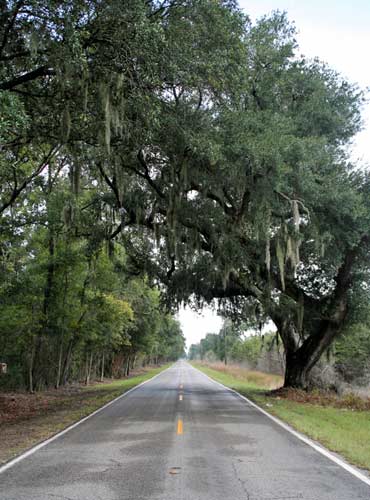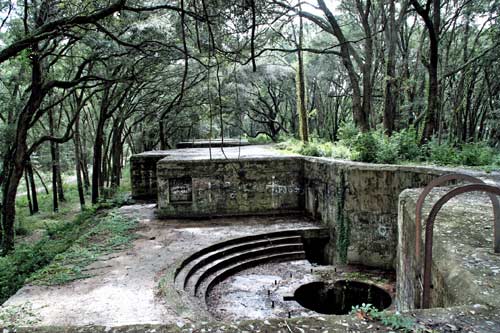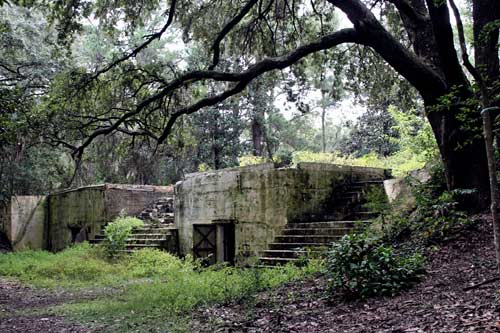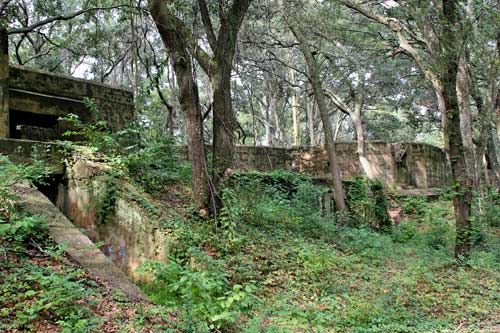Fort Fremont – Lands End, St. Helena Island, South Carolina
Also see: Lands End Light | More SC History, Genealogy Resources
This article and the photos that accompany it were contributed by Barry Gooch, a native of Port Royal in Beaufort County who enjoys studying local history and exploring our state. He is a valuable resource on the backroads and hidden treasures of South Carolina.
History of Ft. Fremont
Located at the southwestern tip of St. Helena Island in Beaufort County, Fort Fremont was constructed in 1899 to defend Port Royal Sound.
 This old tree stands along the road to Fort Fremont and is a popular landmark for adventurous investigators of the paranormal. If you park on the right side of the road facing the tree, you may see the ghostly Lands End Light. © Barry Gooch |

Facing Port Royal Sound (to the right of this photograph), Battery Fornance was armed with two 4.7-inch cannons. The guns were mounted on an elevating platform which would raise the cannons to fire at enemy ships, then lower them behind the protection of the sand and concrete ramparts. © Barry Gooch |
At its peak, the fort covered 70 acres and included a hospital, barracks, stables, guardhouses, commissary, and numerous support buildings. Garrisoned by approximately 110 men and officers of the 116th Coast Artillery, the fort was never involved in military action and the batteries were decommissioned in 1901. Only two batteries and the hospital building remain.

This concrete structure may have been the oil bunker for the old fort. The hospital is located to the left of the photograph and is now part of a private residence. © Barry Gooch |
In 1910, violence erupted between men of the 116th and local Blacks over the purchase of illegal whiskey. There were several brawls and gunfights, and one fight resulted in the death of Private Frank Quigley. Quigley, popular in the Beaufort social circle because of his involvement with a local baseball team, is rumored to be the source of the ghostly "Lands End Light," occasionally seen drifting down the deserted road leading to Fort Fremont.
 Obsolete by the time it was completed, the hardened fortifications of Fort Fremont were proven to be of little protection against modern artillery. Overgrown by the maritime forest, Battery Jesup once mounted two 10-inch cannons. Today, Fort Fremont stands in mute testimony to the bygone era of coastal fortifications. © Barry Gooch |
Ft. Fremont References and Resources
- Fort Fremont is located .3 miles from Lands End Road on St. Helena Island in Beaufort County.
- Fort Fremont Historical Preserve - Friends of Fort Fremont Historical Park
– History of Fort Fremont
- Fort Fremont Battery - National Register of Historic Places
– Nomination form - PDF
– Photographs, overview
- Fort Fremont Hospital - National Register of Historic Places
– Nomination form - PDF
– Photographs, architectural overview
Charleston Hotels
Columbia Hotels
Greenville Hotels
Myrtle Beach Hotels
Charleston Real Estate
Columbia Real Estate
Greenville Real Estate
Myrtle Beach Real Estate
Charleston Jobs
Columbia Jobs
Greenville Jobs
Myrtle Beach Jobs
SC Arts & Entertainment
SC Businesses
SC Calendar of Events
SC Churches
SC Cities, Towns
SC Colleges, Universities
SC Consumer Help Desk
SC Counties
SC Education
SC Elections
SC Facts & Firsts
SC Genealogy
SC Gifts
SC Government, Politics
SC Health, Medicine
SC History
SC Hotels
SC Jobs
SC Libraries, Museums
SC Maps
SC News
SC Movies
SC Organizations
SC Photo Gallery
SC Plantations
SC Pronunciations
SC Real Estate
SC Restaurants
SC Schools
SC Sports, Recreation
SC Tax Guide
SC Tides
SC Tourism
SC Vacation Rentals
SC Web Cams
SC Weddings




